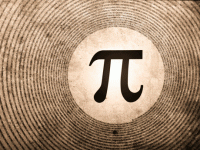The Case for Pi: Why We Shouldn’t Always Teach Math in Absolutes
A few years ago, Indira Gil, friend and math educator in Miami, Forida, asked me the following:
"Why do we call pi irrational when it's clearly the ratio of a circle's circumference to its diameter?"
Of course, I agreed. Such a pithy thought has swum around my ear for as long as it has because we've come to no resolution on it. For decades, we were always told to truncate pi to 3.14 or 22/7. The geeks might get a few digits deeper (3.1415926535. . .), but generally, this was a given fact and, like many things math, we didn't have to wonder because all the wondering had been done for us.
Years later, I rebuke all of this.
Improper, Odd and Radical?
Now, as a math educator, I see potential in redefining some of our math terms to make them easier to explore. With pi, we've seen activities where students put a string around a circular object, like a wheel or a ball, and measure the resulting string. They chart their results and usually come to the idea that, yes, it's really hard to get to the perfect circle or the perfect measurement -- which should be the idea there.
I'm a fan of math that leaves us in suspense. With that said, here are three others that deserve a rethink.
Improper Fractions
I get it. The purists want 15/4 reduced to 3-3/4, but to call it improper is extreme. I also find that the word "improper" signals to the student that the fraction is somehow wrong and unwanted. What's improper about a fraction like 15/4 when, for instance, you're trying to multiply it by 9? As an improper fraction, it's a three-step process. As a mixed number, it's at least a five-step process. Improper might be the only word we have for this type of ratio, but we would benefit from exploring the idea of improper, well, properly.
Odd Numbers
There's nothing odd about odd numbers! If anything, they're absolutely fine just the way they are. I almost prefer the word "uneven," as it makes more sense and has more connections to the ways students learn the concept of 2 and its multiples. Perhaps I just want to see the term that implies 2x + 1 move onto greener pastures, since "odd" is already occupied in so many spheres anyway.
Radical
The term "radical" is often used to signify the square root, but unbeknownst to us, we're revealing our politics depending on how frequently we use the word radical or smile when we do find the root of the problem.
Embracing the Unsolvable
Generally, the case for pi ought to be that it's a prototypical case of a math unsolvable, a number that laughs at the rules we purport to set for it even as we brandish all these axioms that serve as nothing more than flimsy boundaries for the unsolvables. Exploring the unknown, the uncharted or the simply irregular can work well to get students comfortable with math, if only because most of us math people have given them some odd challenge we want them to solve -- or because they need our class to earn a degree.
The fortunate thing for pi is that it doesn't have to worry about false translations. The word pi, even though it's said like a delicious pastry, still occupies its own space in the national zeitgeist. But it might be more interesting to show students why pi matters. In middle school, this looks like deconstructing formulas. For example, we use pi in the surface area and volumes of a cylinder. Why does pi matter when measuring the edges? Can we truly ever get a perfect cylinder knowing that we can't actually get pi right? What does "perfect" mean in this case?
Thus, I implore everyone to reconsider their math and update their terms of use. Instead of teaching math as facts, teach it as a set of things that we have yet to explore, but can and should. Even after we believe that we've mastered the concept, the challenge then becomes turning that knowledge into something teachable. Hopefully, that challenge is as confounding as the number 3.1415926535. . .
